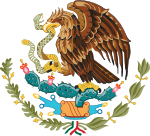Hernán Cortés
| Hernán Cortés | |
|---|---|
 | |
| Personlig information | |
| Født | Hernán Cortés y Pizarro 1485 Medellín, Spanien |
| Død | 2. december 1547 Castilleja de la Cuesta, Spanien |
| Dødsårsag | Dysenteri, lungehindebetændelse |
| Gravsted | Mexico City |
| Far | Martín Cortés de Monroy |
| Mor | Catalina Pizarro Altamarino |
| Ægtefæller | Juana Ramírez de Arellano y Zúñiga (til 1583), Catalina Juárez (1512-1522) |
| Partnere | La Malinche, Isabel Moctezuma |
| Børn | Doña Juana Cortés de Zuñiga, Doña Maria Cortés y Ramirez de Arellano, Martín Cortés, Martín Cortés Zúñiga, Leonor Cortés Moctezuma |
| Uddannelse og virke | |
| Beskæftigelse | Opdagelsesrejsende, conquistador, guvernør |
| Fagområde | Conquistador |
| Nomineringer og priser | |
| Udmærkelser | Santiago-ordenen |
| Signatur | |
 | |
| Information med symbolet | |
Hernán Cortés (også kaldet Hernando eller Fernando Cortés, han underskrev alle sine breve Fernán Cortés; født 1485, død 2. december 1547) var en conquistador, der med få hundrede spaniere og flere tusinde mesoamerikanere erobrede Mexico for Spanien, ødelagde Tenochtitlán, aztekernes hovedstad og hovedsæde for et af de største imperier i Mesoamerika.[1] Han opløste aztekerriget under kejser Moctezuma II og dennes efterfølger, Cuauhtemoc og banede vejen for etableringen af den spanske kolonimagt på det amerikanske fastland.
Cortezhavet er opkaldt efter Hernán Cortés.
Referencer
- ^ Oudijk, Michel og Matthew Restall. 2007. Mesoamerican Conquistadors in the Sixteenth Century. I: Indian Conquistadors. Red. af Laura E. Mattew. University of Oklahoma Press.
Eksterne henvisninger
| Spire |
Medier brugt på denne side
This work is an anonymous portrait of the famous Spanish conqueror Hernán Cortés (C.E.1485-1547), based on the painting sent by the portrayed himself to Paulo Giovio, in which he appeared in profile and with a hat, serving as a model work for many representations of his bust from the C.E.16th century onwards.
Signature of Hernán Cortés





